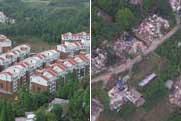China
Exhibition testimony to progress in Tibet
Source: China Daily | 05-02-2008 11:18
Special Report: Tibet TodayBEIJING, May 2 -- Huang Guangxue, vice-director of the National State Nationalities Affairs Commission in the 1980s, still remembers his first visit to Tibet in 1954. Huang and his colleagues were on a State Council mission to assess the situation in the region.
The young man, who grew up in the countryside, was struck by the poverty of the Tibetans.
In the northern pasture areas, Huang saw Tibetans dressed in rags, huddled around fires of yak dung to keep warm.
When Huang visited Tibet again in 1959, it took him a week to travel from Urumqi, capital of Xinjiang Uygur autonomous region, to reach the remote Ngari region of western Tibet.
"The changes since have been tremendous," Huang said at the grand exhibition - Tibet of China: Past and Present - that opened on Wednesday at the Cultural Palace of Nationalities in Beijing.
The cultural relics, pictures and other exhibits on display provide ample evidence of the changes in Tibet.
Before 1959, serfs comprised more than 95 percent of the population, but 80 percent of the assets were controlled by serf owners - officials, aristocrats and monasteries.
According to the Thirteen and Sixteen Statutes practiced in Tibet from the 17th century until 1959, it was stated that each noble was worth his weight in gold. People at the lowest level - women, vagrants, beggars, butchers and blacksmiths - were only worth a length of rope made of grass.
At the exhibition, the song Heavenly Road that praises the Qinghai-Tibet Railway can be heard in the background.
One picture shows a happy Tibetan family around a table covered with food during a festival. Alongside, is a 1950s photo showing a beggar taking shelter in a toilet in Lhasa.
A graphic on food production shows that in 1959 one-fifteenth of a hectare of farmland only produced 91 kg of grain. In 2007, production had increased to 364 kg. Over the same period, the per capita income of the rural and pastoral population had quadrupled from 175 yuan to 2,788 yuan.
Tashi, a sophomore at the Central University for Nationalities, was impressed by the cultural relics he was seeing for the first time. Tashi is majoring in Tibetology, taught by Tibetan and Han teachers.
Tuition at the university is free and each student receives a monthly subsidy of 52 yuan from the government.
Tashi comes from the Yushu Tibetan prefecture of Qinghai province. When he returned home last year, it took him only 24 hours to reach Xining, capital of Qinghai, via the second phase of the Qinghai-Tibet Highway which opened in July 2006. "It's quite convenient for me to go home. I do it once a year," Tashi said.
Editor:Du Xiaodan



